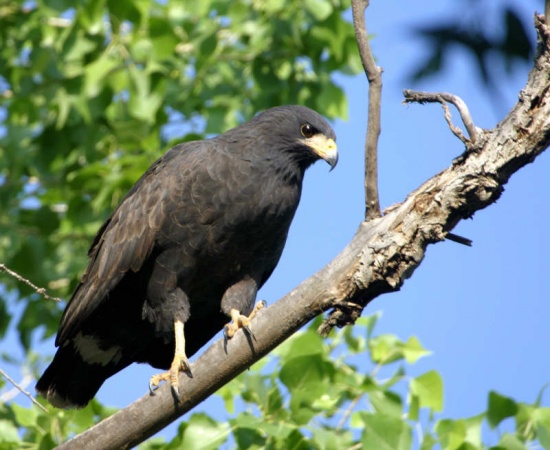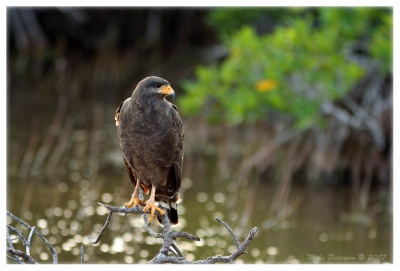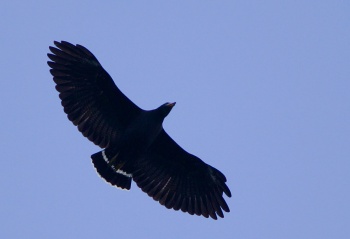m |
(Flight photo. Taxonomy expanded. References) |
||
| Line 1: | Line 1: | ||
| − | [[Image:Common_Black_Hawk.jpg|thumb|550px|right|Photo by bobsofpa<br /> | + | [[Image:Common_Black_Hawk.jpg|thumb|550px|right|Photo by {{user|bobsofpa|bobsofpa}}<br />[[Big Bend National Park]], [[Texas]], [[USA]], March 2004]] |
;[[:Category:Buteogallus|Buteogallus]] anthracinus | ;[[:Category:Buteogallus|Buteogallus]] anthracinus | ||
'''Includes: Cuban Black Hawk''' | '''Includes: Cuban Black Hawk''' | ||
==Identification== | ==Identification== | ||
| − | Length 50-58cm (20-23"), wingspan 122-127cm (48-50") | + | Length 50-58cm (20-23"), wingspan 122-127cm (48-50")<br /> |
As the name implies, this is a very dark hawk; dark brown to almost black, with a yellow bill tipped in black, and some white spotting on the base of the primary flight feathers, and at the tip of the tail. In its limited US range, it is most easily identified by chunky shape and broad white band crossing middle of tail. Further south compare the [[Great Black Hawk]] and the rare [[Solitary Eagle]]. | As the name implies, this is a very dark hawk; dark brown to almost black, with a yellow bill tipped in black, and some white spotting on the base of the primary flight feathers, and at the tip of the tail. In its limited US range, it is most easily identified by chunky shape and broad white band crossing middle of tail. Further south compare the [[Great Black Hawk]] and the rare [[Solitary Eagle]]. | ||
| + | [[Image:Cuban blackhawk.jpg|thumb|400px|right|Cuban Black Hawk<br />Photo by {{user|mrmike|mrmike}}<br />[[Cuba]], January 2007]] | ||
==Distribution== | ==Distribution== | ||
Found in coastal regions of northern and north-western [[South America]], incl. [[Trinidad]] & [[Tobago]], north through [[Central America]] and [[Mexico]], to southernmost [[USA]] ([[Arizona]] and [[Texas]]). Generally resident, but some local movements, and only a summer visitor to south-eastern Arizona. Also seen along border section of Rio Grande River, notably in Big Bend NP, in winter. Very rare visitor to lower Rio Grande Valley, Texas. A resident population also occurs on [[Cuba]]. | Found in coastal regions of northern and north-western [[South America]], incl. [[Trinidad]] & [[Tobago]], north through [[Central America]] and [[Mexico]], to southernmost [[USA]] ([[Arizona]] and [[Texas]]). Generally resident, but some local movements, and only a summer visitor to south-eastern Arizona. Also seen along border section of Rio Grande River, notably in Big Bend NP, in winter. Very rare visitor to lower Rio Grande Valley, Texas. A resident population also occurs on [[Cuba]]. | ||
| − | + | ====Conservation Status==== | |
| + | Overall common and widespread. In its limited US range it is rare and local, with an estimated 250 breeding pairs remaining. | ||
==Taxonomy== | ==Taxonomy== | ||
| − | Recent evidence strongly suggests that the population on Cuba should be considered a separate species, the Cuban Black Hawk (''Buteogallus gundlachii''). On the contrary, recent evidence strongly suggests that the [[Mangrove Black Hawk]] should be considered a subspecies, ''B. anthracinus subtilis'', of the Common Black Hawk. | + | Recent evidence strongly suggests that the population on Cuba should be considered a separate species, the Cuban Black Hawk (''Buteogallus gundlachii''). On the contrary, recent evidence strongly suggests that the [[Mangrove Black Hawk]] should be considered a subspecies, ''B. anthracinus subtilis'', of the Common Black Hawk; this lump has already been accepted by Clements. |
| + | [[Image:4381Common Black Hawk in flight.jpg|thumb|350px|right|Photo by {{user|Steve+G|Steve G}}<br />Arima Valley, Northern [[Trinidad]], May 2006]] | ||
| + | ====Subspecies<sup>[[#References|[1]]]</sup>==== | ||
| + | *''B. a. anthracinus'': | ||
| + | :*South-western [[US]] to northern [[South America]], St. Vincent and [[Trinidad]] | ||
| + | *''B. a. utilensis'': | ||
| + | :*Cancún, Cozumel Island and islands in Gulf of Honduras | ||
| + | *''B. a. rhizophorae'': | ||
| + | :*Pacific coast of [[El Salvador]] and [[Honduras]] | ||
| + | *''B. a. bangsi'': | ||
| + | :*Pacific coast of [[Costa Rica]] and [[Panama]]; Pearl Islands | ||
| + | *''B. a. subtilis'': | ||
| + | :*Pacific coast of [[Colombia]], [[Ecuador]] and extreme northern [[Peru]] | ||
==Habitat== | ==Habitat== | ||
| − | Wide range of wooded habitats, especially in coastal areas. | + | Wide range of wooded habitats, especially in coastal areas. In the northernmost parts of its range, nests most commonly in cottonwood trees in riparian areas. |
| − | |||
==Behaviour== | ==Behaviour== | ||
| − | + | Gentle and lethargic except while nesting, when it often drops out of the skies from great height. | |
| − | + | ====Breeding==== | |
| − | + | Will abandon nest if disturbed too much. | |
==External Links== | ==External Links== | ||
{{GSearch|Buteogallus+anthracinus}} | {{GSearch|Buteogallus+anthracinus}} | ||
| − | [[Category:Birds]][[Category:Buteogallus]] | + | <br /> |
| + | {{Video|Common_Black_Hawk}} | ||
| + | [[Category:Birds]][[Category:Buteogallus]] [[Category:Videos]] | ||
Revision as of 08:34, 5 September 2010
- Buteogallus anthracinus
Includes: Cuban Black Hawk
Identification
Length 50-58cm (20-23"), wingspan 122-127cm (48-50")
As the name implies, this is a very dark hawk; dark brown to almost black, with a yellow bill tipped in black, and some white spotting on the base of the primary flight feathers, and at the tip of the tail. In its limited US range, it is most easily identified by chunky shape and broad white band crossing middle of tail. Further south compare the Great Black Hawk and the rare Solitary Eagle.
Distribution
Found in coastal regions of northern and north-western South America, incl. Trinidad & Tobago, north through Central America and Mexico, to southernmost USA (Arizona and Texas). Generally resident, but some local movements, and only a summer visitor to south-eastern Arizona. Also seen along border section of Rio Grande River, notably in Big Bend NP, in winter. Very rare visitor to lower Rio Grande Valley, Texas. A resident population also occurs on Cuba.
Conservation Status
Overall common and widespread. In its limited US range it is rare and local, with an estimated 250 breeding pairs remaining.
Taxonomy
Recent evidence strongly suggests that the population on Cuba should be considered a separate species, the Cuban Black Hawk (Buteogallus gundlachii). On the contrary, recent evidence strongly suggests that the Mangrove Black Hawk should be considered a subspecies, B. anthracinus subtilis, of the Common Black Hawk; this lump has already been accepted by Clements.
Subspecies[1]
- B. a. anthracinus:
- South-western US to northern South America, St. Vincent and Trinidad
- B. a. utilensis:
- Cancún, Cozumel Island and islands in Gulf of Honduras
- B. a. rhizophorae:
- Pacific coast of El Salvador and Honduras
- B. a. bangsi:
- Pacific coast of Costa Rica and Panama; Pearl Islands
- B. a. subtilis:
Habitat
Wide range of wooded habitats, especially in coastal areas. In the northernmost parts of its range, nests most commonly in cottonwood trees in riparian areas.
Behaviour
Gentle and lethargic except while nesting, when it often drops out of the skies from great height.
Breeding
Will abandon nest if disturbed too much.
External Links






